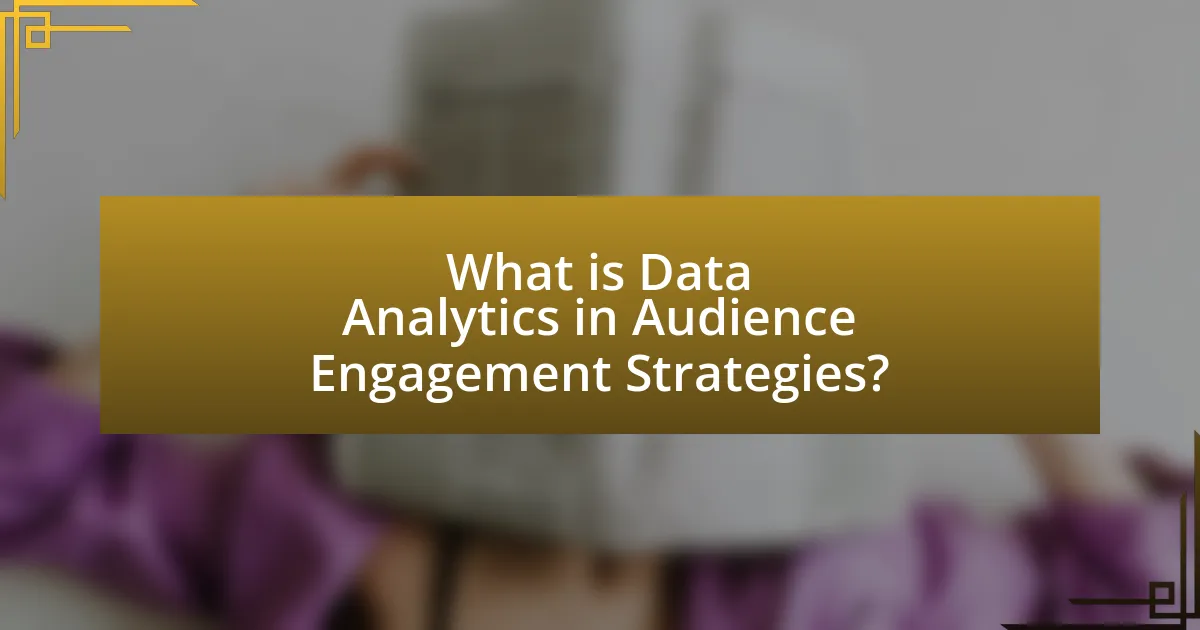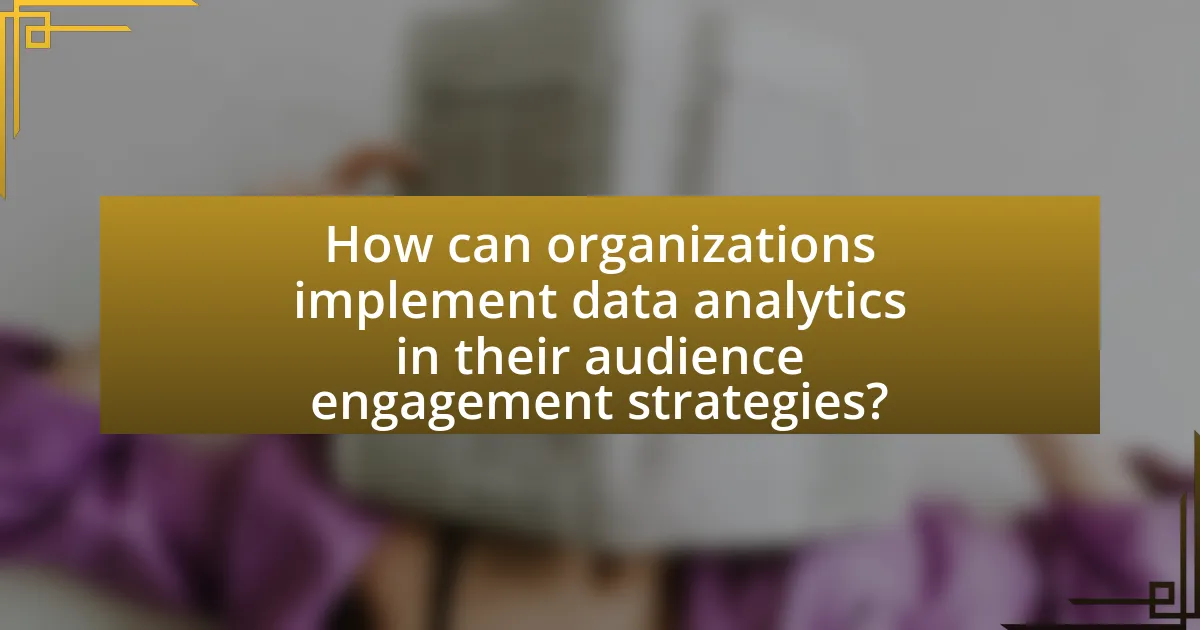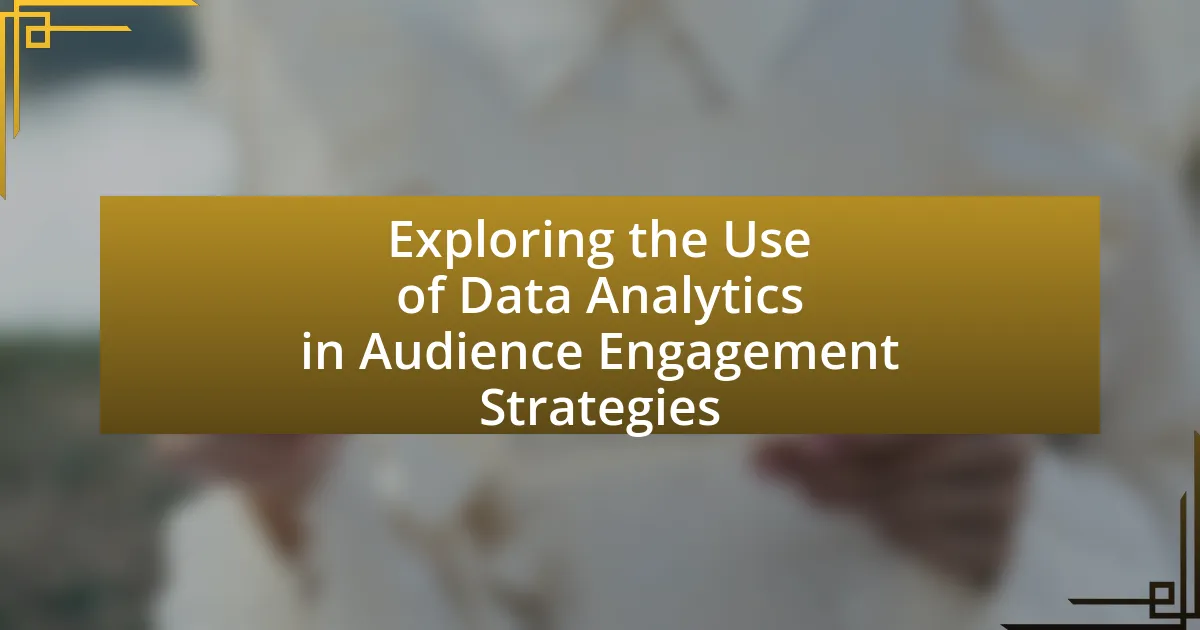Data analytics plays a crucial role in audience engagement strategies by systematically analyzing audience behavior and preferences to enhance interactions. The article explores how data analytics improves engagement through insights derived from various metrics, such as engagement rates and conversion rates, which inform targeted marketing strategies. It discusses different types of analytics, including descriptive, diagnostic, predictive, and prescriptive analytics, and highlights the importance of data quality and privacy in implementing effective analytics practices. Additionally, the article outlines best practices for organizations to maximize the effectiveness of data analytics in engaging their audience while avoiding common pitfalls.

What is Data Analytics in Audience Engagement Strategies?
Data analytics in audience engagement strategies refers to the systematic analysis of data related to audience behavior and preferences to enhance interaction and connection with them. This process involves collecting, processing, and interpreting data from various sources, such as social media, website analytics, and customer feedback, to identify trends and insights that inform engagement tactics. For instance, a study by McKinsey & Company found that organizations leveraging data analytics can improve their marketing effectiveness by up to 15-20%, demonstrating the significant impact of data-driven strategies on audience engagement.
How does data analytics enhance audience engagement?
Data analytics enhances audience engagement by providing insights into audience behavior and preferences, allowing organizations to tailor their content and interactions effectively. By analyzing data such as user interactions, demographics, and feedback, organizations can identify trends and patterns that inform targeted marketing strategies. For instance, a study by McKinsey & Company found that companies leveraging data analytics for customer engagement can increase their marketing ROI by 15-20%. This targeted approach not only improves the relevance of content but also fosters a deeper connection with the audience, ultimately leading to higher engagement rates.
What are the key metrics used in audience engagement analytics?
Key metrics used in audience engagement analytics include engagement rate, click-through rate (CTR), conversion rate, average session duration, and bounce rate. Engagement rate measures the level of interaction users have with content, often expressed as a percentage of total views or impressions. Click-through rate indicates the percentage of users who click on a specific link compared to the total number of users who view the content. Conversion rate tracks the percentage of users who complete a desired action, such as signing up or making a purchase, relative to the total number of visitors. Average session duration reflects the average time users spend on a website or app, indicating how engaging the content is. Bounce rate measures the percentage of visitors who leave the site after viewing only one page, providing insight into content effectiveness. These metrics are essential for evaluating and optimizing audience engagement strategies.
How do these metrics influence engagement strategies?
Metrics significantly influence engagement strategies by providing data-driven insights that help organizations tailor their approaches to audience preferences and behaviors. For instance, metrics such as click-through rates, conversion rates, and user engagement levels allow marketers to identify which content resonates most with their audience. This enables them to optimize their messaging and delivery channels accordingly. Research from HubSpot indicates that companies using data analytics to inform their engagement strategies see a 20% increase in customer retention rates, demonstrating the effectiveness of leveraging metrics for improved audience interaction.
Why is data analytics important for understanding audience behavior?
Data analytics is crucial for understanding audience behavior because it enables organizations to derive actionable insights from large datasets. By analyzing patterns in audience interactions, preferences, and demographics, businesses can tailor their strategies to meet the specific needs and interests of their target audience. For instance, a study by McKinsey & Company found that companies leveraging data analytics effectively can increase their marketing ROI by 15-20%. This demonstrates that data-driven decisions lead to more effective audience engagement and improved customer satisfaction.
What insights can data analytics provide about audience preferences?
Data analytics can provide insights into audience preferences by identifying patterns in behavior, engagement levels, and content consumption. For instance, analytics tools can track metrics such as click-through rates, time spent on content, and demographic information, allowing organizations to tailor their strategies to meet the specific interests of their audience. A study by McKinsey & Company found that companies leveraging data analytics to understand customer preferences can increase their marketing ROI by 15-20%. This demonstrates that data-driven insights are crucial for optimizing audience engagement and enhancing overall satisfaction.
How can these insights shape content creation and distribution?
Insights from data analytics can significantly shape content creation and distribution by enabling targeted strategies that resonate with specific audience segments. By analyzing audience behavior, preferences, and engagement metrics, content creators can tailor their messaging and formats to meet the needs of their target demographics. For instance, a study by HubSpot found that personalized content can increase engagement rates by up to 202%. This data-driven approach allows for more efficient allocation of resources in content distribution, ensuring that the right content reaches the right audience at optimal times, thereby enhancing overall engagement and effectiveness.

What are the different types of data analytics used in audience engagement?
The different types of data analytics used in audience engagement include descriptive analytics, diagnostic analytics, predictive analytics, and prescriptive analytics. Descriptive analytics focuses on summarizing historical data to understand audience behavior, such as engagement metrics from social media or website traffic. Diagnostic analytics examines the reasons behind audience behaviors by analyzing patterns and correlations, helping to identify what drives engagement. Predictive analytics uses statistical models and machine learning techniques to forecast future audience behaviors based on historical data, allowing organizations to tailor their strategies accordingly. Finally, prescriptive analytics provides recommendations for actions to optimize audience engagement, often utilizing algorithms to suggest the best course of action based on data insights. Each type plays a crucial role in enhancing audience engagement strategies by providing actionable insights derived from data analysis.
What is descriptive analytics and how does it apply to audience engagement?
Descriptive analytics is the process of analyzing historical data to understand trends and patterns, providing insights into what has happened in the past. In the context of audience engagement, descriptive analytics applies by enabling organizations to assess past audience behaviors, preferences, and interactions, which helps in tailoring future engagement strategies. For instance, by analyzing metrics such as website traffic, social media interactions, and email open rates, organizations can identify which content resonated most with their audience, allowing for more targeted and effective communication in future campaigns. This data-driven approach enhances the ability to engage audiences by aligning content with their interests and behaviors, ultimately improving overall engagement outcomes.
What tools are commonly used for descriptive analytics?
Common tools used for descriptive analytics include Microsoft Excel, Tableau, Google Analytics, and Power BI. These tools enable users to summarize and visualize data effectively, facilitating insights into trends and patterns. For instance, Microsoft Excel is widely utilized for its data manipulation capabilities, while Tableau is known for its advanced data visualization features. Google Analytics provides web traffic analysis, and Power BI integrates data from various sources for comprehensive reporting. Each of these tools supports organizations in making data-driven decisions by presenting historical data in an accessible format.
How can descriptive analytics inform future engagement strategies?
Descriptive analytics can inform future engagement strategies by providing insights into past audience behaviors and preferences. By analyzing historical data, organizations can identify trends, such as peak engagement times and content types that resonate most with their audience. For instance, a study by the Harvard Business Review found that companies leveraging descriptive analytics saw a 10-15% increase in customer engagement by tailoring their strategies based on data-driven insights. This evidence demonstrates that understanding past interactions allows organizations to optimize future engagement efforts effectively.
What role does predictive analytics play in audience engagement?
Predictive analytics plays a crucial role in audience engagement by enabling organizations to anticipate audience behaviors and preferences. This data-driven approach allows marketers to tailor content and interactions, enhancing the relevance of their messaging. For instance, a study by McKinsey & Company found that companies using predictive analytics in their marketing strategies can increase customer engagement by up to 20%. By analyzing historical data and identifying patterns, predictive analytics helps businesses create personalized experiences that resonate with their audience, ultimately driving higher engagement rates.
How can predictive models forecast audience behavior?
Predictive models forecast audience behavior by analyzing historical data to identify patterns and trends that inform future actions. These models utilize algorithms that process variables such as demographics, past interactions, and engagement metrics to predict how audiences are likely to respond to various stimuli, such as marketing campaigns or content changes. For instance, a study by the Journal of Marketing Research found that predictive analytics can improve customer retention rates by up to 15% by accurately forecasting which customers are at risk of disengagement. This demonstrates that predictive models not only enhance understanding of audience behavior but also enable targeted strategies that can significantly impact engagement outcomes.
What are the limitations of predictive analytics in this context?
Predictive analytics has several limitations in the context of audience engagement strategies. One significant limitation is the reliance on historical data, which may not accurately reflect future behaviors due to changing audience preferences or external factors. For instance, a study by the Journal of Marketing Research indicates that consumer behavior can shift rapidly, making past data less relevant for future predictions. Additionally, predictive models can suffer from biases inherent in the data, leading to skewed insights that do not represent the entire audience. Furthermore, the complexity of audience dynamics can result in oversimplified models that fail to capture nuanced interactions, as highlighted in research published by the Harvard Business Review. These limitations can hinder the effectiveness of audience engagement strategies, as they may not fully account for the variability and unpredictability of audience behavior.

How can organizations implement data analytics in their audience engagement strategies?
Organizations can implement data analytics in their audience engagement strategies by utilizing customer data to tailor content and interactions. By analyzing demographic information, behavioral patterns, and engagement metrics, organizations can identify audience preferences and optimize their messaging accordingly. For instance, a study by McKinsey found that companies using data-driven marketing are six times more likely to be profitable year-over-year. This demonstrates that leveraging data analytics not only enhances audience targeting but also drives higher engagement and conversion rates.
What steps should organizations take to integrate data analytics?
Organizations should take the following steps to integrate data analytics: first, they must define clear objectives for data analytics that align with their overall business goals. This involves identifying key performance indicators (KPIs) that will measure success. Next, organizations should invest in the necessary technology and tools, such as data management platforms and analytics software, to facilitate data collection and analysis.
Following this, they need to ensure data quality by implementing processes for data cleaning and validation, which is crucial for accurate insights. Additionally, organizations should foster a data-driven culture by training employees on data literacy and analytics tools, enabling them to make informed decisions based on data insights.
Finally, organizations should establish a feedback loop to continuously assess and refine their analytics strategies, ensuring they adapt to changing business needs and market conditions. This structured approach is supported by research indicating that organizations with a clear analytics strategy are 5 times more likely to make decisions based on data rather than intuition alone.
What technologies are essential for effective data analytics implementation?
Essential technologies for effective data analytics implementation include data warehousing solutions, data visualization tools, and machine learning algorithms. Data warehousing solutions, such as Amazon Redshift or Google BigQuery, enable the storage and management of large datasets, facilitating efficient data retrieval and analysis. Data visualization tools like Tableau or Power BI allow users to create interactive dashboards, making complex data more understandable and actionable. Machine learning algorithms, implemented through platforms like TensorFlow or Scikit-learn, enhance predictive analytics by identifying patterns and trends within the data. These technologies collectively support organizations in deriving insights that drive audience engagement strategies.
How can organizations ensure data quality and accuracy?
Organizations can ensure data quality and accuracy by implementing robust data governance frameworks and regular data validation processes. A strong data governance framework establishes clear policies, standards, and responsibilities for data management, which helps maintain consistency and reliability across datasets. Regular data validation processes, such as automated checks and manual audits, identify and rectify errors, ensuring that the data remains accurate and up-to-date. According to a study by the Data Management Association, organizations with effective data governance practices experience a 30% improvement in data quality, highlighting the importance of these strategies in achieving high data accuracy.
What best practices should organizations follow when using data analytics?
Organizations should follow best practices such as defining clear objectives, ensuring data quality, and fostering a data-driven culture when using data analytics. Clear objectives guide the analytics process, helping organizations focus on relevant metrics and outcomes. Ensuring data quality is crucial, as accurate and reliable data leads to better insights; studies show that poor data quality can cost organizations up to 30% of their revenue. Fostering a data-driven culture encourages collaboration and empowers employees to leverage data in decision-making, which can enhance audience engagement strategies significantly.
How can organizations maintain audience privacy while using data analytics?
Organizations can maintain audience privacy while using data analytics by implementing robust data governance frameworks and employing anonymization techniques. Data governance frameworks establish clear policies for data collection, usage, and sharing, ensuring compliance with regulations such as GDPR and CCPA. Anonymization techniques, such as data masking and aggregation, help to protect individual identities by removing personally identifiable information (PII) from datasets. For instance, a study by the International Association of Privacy Professionals highlights that organizations that adopt these practices can significantly reduce the risk of data breaches and enhance consumer trust.
What are common pitfalls to avoid in data analytics for audience engagement?
Common pitfalls to avoid in data analytics for audience engagement include relying on incomplete data, neglecting audience segmentation, and failing to measure the right metrics. Incomplete data can lead to inaccurate insights, as decisions based on partial information may not reflect the true audience behavior. Neglecting audience segmentation results in a one-size-fits-all approach, which can alienate specific groups and reduce engagement effectiveness. Additionally, failing to measure the right metrics, such as focusing solely on vanity metrics instead of actionable insights, can misguide strategies and hinder meaningful engagement. These pitfalls can significantly undermine the effectiveness of data analytics in enhancing audience engagement.
What are practical tips for maximizing the effectiveness of data analytics in audience engagement?
To maximize the effectiveness of data analytics in audience engagement, organizations should focus on integrating real-time data analysis into their engagement strategies. Real-time analytics allows businesses to respond promptly to audience behaviors and preferences, enhancing personalization and relevance in communication. For instance, a study by McKinsey found that companies using real-time data analytics can increase their marketing ROI by 15-20%. Additionally, segmenting the audience based on data insights enables targeted messaging, which has been shown to improve engagement rates significantly. Implementing A/B testing based on analytics can also refine strategies by identifying what resonates best with the audience, leading to more effective campaigns.

Leave a Reply